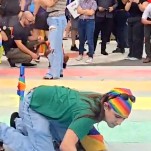Meet Johanne Rahaman, the Photographer Documenting Florida's Black Communities
EntertainmentJohanne Rahaman is used to being invisible. Before she was a resident, and finally a citizen of the United States, the 47-year-old, Miami-based photographer practiced living under the radar, purposefully unseen. “Invisibility is what I’ve done for so long,” Rahaman told Jezebel. Purposefully or not, it’s that sense of being unseen that drives Rahaman’s photography: for the last few years, she’s been photographing Florida’s black towns and communities, creating what she describes as “snapshots of a community in my time,” for her ongoing project, Black Florida.
Black Florida isn’t simply a collection of photographs, it’s a long-term project dedicated to both rendering black communities visible and preserving those images for future generations. Rahaman describes Black Florida as an archive of sorts, of both photographs and oral histories that amount to a “collection of a community’s history.” Though the archive might seem like a neutral place, Black Florida reveals that it’s deeply bound to visibility—a concept that is tied to both political power and cultural authority. Who the camera sees and how he or she captured, is tied to the history of photography, one in which bodies of color are visually tied to a range of negative visual tropes, from disease to social ills and scientific experiments.
Rahaman’s project is a clear rejoinder to that part of the history of photography, purposefully conjuring up the photojournalism of Gordon Parks or the glamorous black and white photographs of the Harlem Renaissance by James Van Der Zee. “Since segregation ended, the entire working class black community hasn’t really been looked at in a compassionate way, especially in the eyes of photographers,” Rahaman says. She’s interested in counteracting photographic sensationalism and turns her camera away from what she describes as “images of negating,” instead refocusing her lens towards the joy of black communities (she cites Parks as a conscious influence).
-

-

-

-

-

-

-

-

-

-

-

-

-

-

-

-

-

-

-

-

-

-

-

-

-

-

-

-

-

-

-

-

-

-

-

-

-

-

-

-








































